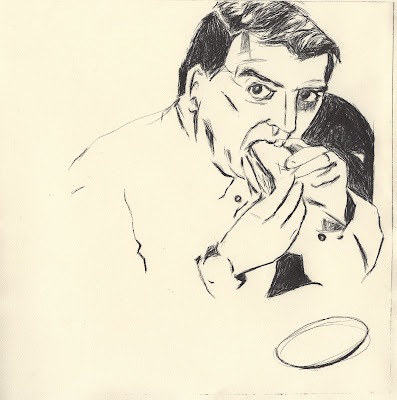I'd like to expound upon the somewhat inept
explanations of my first post to discuss in brief some of the basic principles according to which I am painting. I would like to make clear that these ideas are applied only to my painting work. I had some trouble in the past few months attempting to apply them to my illustration projects, but came to understand that it could not be done
successfully. First my flexible
guiding principle which states that subject matter is essentially arbitrary. There are a number of reasons for this. One, both within the visual realm and the metaphors of paint, all objects are exactly the same thing- be it reflected light or marks on canvas. The difference between objects in their visual qualities then becomes merely a formal exercise to reproduce. True, society lays various judgements and implications on different objects, but it is my belief that at this point in painting's history, all objects in being rendered bear a base level of cliche. I believe that the stylistic manner in which an object is depicted is therefore more important that the object itself. However, this realm too is greatly fraught with cliche. Above this admitedly half-baked notion is the
firmer idea that "abstract painting" as such is a non-existant and arbitrary distiction. This is true for the reasons already discussed. Because all renderings are necesarilly abstract, this label hinges upon individual reception and artist intentionallity, two hopeleslly tangled concepts. For example, if a viewer fails to recognize Monet's waterlilies as such, the work may now become abstract. They would have to be aware of the intentions of Monet himself to understand that he meant for the work to be a "literal" translation. However, I would enter the "intentions" of the artist, even as indicated in a title, such as in this case, as invalid. Few people consider Pollocks "Blue Poles" to be a "literal" image- certainly not a painting of blue poles! However, Pollock was known to sometimes create his images from accumulations of crude drawings in paint. These would eventually obscure one another and become unreadable. Did Pollock intend for this to be the case? Perhaps someone would read one of his images as a representational view of a specific wall. Maybe the paint is a metaphor for mold or rust. Or maybe it is paint. For me, the distiction between abstract and representational work is so slippery and subjective as to be entirely invalid. And this is something that I am always conscious of while creating my own work.





